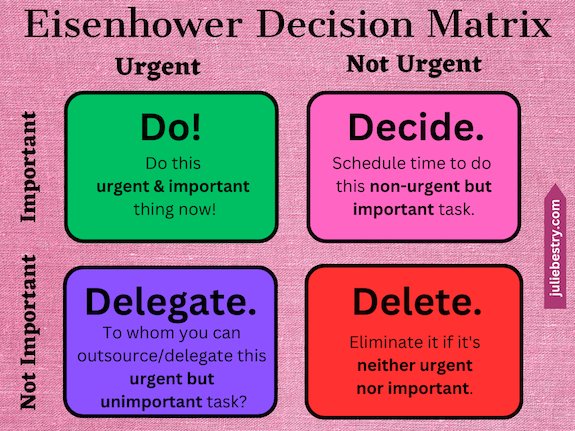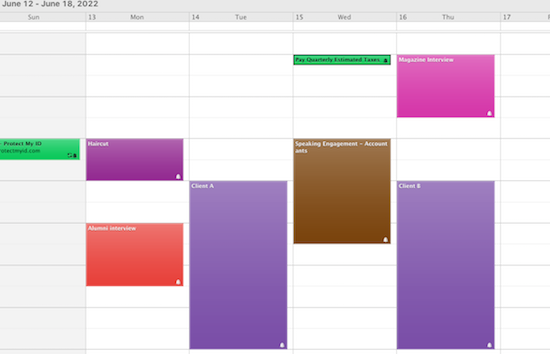Use the Rule of 3 to Improve Your Productivity

It’s Monday — the first Monday of a new month, of a new quarter, and the last quarter of the year. It may suddenly feel like a lot is riding on getting things crossed of your list so you can make those dreams come true before 2023 is in the rear-view mirror.
RECAPPING THE ESSENTIALS OF TACKLING YOUR TO-DO LIST
Back in May, in Frogs, Tomatoes, and Bees: Time Techniques to Get Things Done, we looked at a spate of productivity concepts for breaking down the hours of your (preferably time-blocked) day to effectively use your discretionary time (that is, the part of your schedule not determined by your boss, school, or firmly-scheduled obligations). We started with the essential elements of accomplishing things:
Knowing what to do — This involves a brain dump to capture every potential task stuck in your head, adding to it from everything in your various in-boxes and buckets (GTD-style), and creating a master list, whether that’s pen-on-paper or a task app.
Knowing what to do first — Prioritizing tasks involves a complex intersection of what is important and urgent. We shorthanded the process with the Eisenhower Matrix (which, as explained in Paper Doll Shares Presidential Wisdom on Productivity, wasn’t invented by the Ike we like, but was attributed to him due to a speech he gave and was made more famous by Stephen Covey).

The Eisenhower Matrix gives you the opportunity to (literally or just figuratively) graph each task from your massive brain-dumped list to identify where it falls along a continuum of importance and urgency. From January through mid-April, filing your taxes is important, but it only becomes more urgent as St. Patrick’s Day is behind you and April 15th draws nearer.
Conversely, this Friday’s registration date for an adult education class on French cooking has what appears to be an urgent task; however, if learning how to make Julia Child’s famed Boeuf Bourguignon isn’t that compelling and you were only doing it to please your mother-in-law, it may fall low on the importance scale.
 Julia Child on KUHT/By KUHT via wikimedia commons
Julia Child on KUHT/By KUHT via wikimedia commons
A big part of identifying the value of a task may involve looking at what your motivation is. You perform extrinsically-motivated behaviors in order to receive some external reward (or to avoid an external punishment). You might work at a job for a paycheck, work hard in a class to get the grades that allow you to get a scholarship, or make that Boeuf Bourguignon to keep the peace between family members (because it’s hard for people to snipe when their mouths are full).
Intrinsically-motivated behaviors are those that you do because they fulfill you personally. These include passion projects like volunteering, participating in hobbies and sports, or even simultaneously compelling but challenging life activities, like parenting.
Sometimes, you may find yourself frustrated that the very things you value for your sanity-preserving self-care are less valued by society. (This is largely because, as we discussed in our series on toxic productivity, late-stage capitalism values producing work that yields revenue, generally for the people above you in the hierarchy. Sigh.)
Of course, the ideal is to find opportunities for extrinsically- and intrinsically-motivating behaviors to dovetail. When that happens, the things that are important are easier to accomplish because they give you personal fulfillment and extrinsic rewards.
Making something a high priority, per se, doesn’t ensure that you’ll do it, but if that task is important, not just for keeping you out of debtor’s prison but also making your heart sing, you’ll do it less begrudgingly, and if it’s urgent, you’ll find you’re less likely to procrastinate.
You’re probably not going to find that your love of the game will allow you to become a professional pickleball player — more power to you if you do! — but you may find that by becoming more efficient and effective at your for-a-paycheck job will yield more free time to pursue a passion that could turn into a new livelihood.
Once you gauge your each task’s relative importance and urgency, you can move forward to knowing what to get done today (vs. delaying to later in the week), what you might delegate, and what you can hang it in the maybe/someday closet.
Do it! — The final piece of the puzzle involves making time to do what you’ve decided to accomplish.
MANAGING OUR DAYS BY MANAGING OUR HOURS
Back in that post I referenced, Frogs, Tomatoes, and Bees: Time Techniques to Get Things Done, I reviewed well-known and lesser techniques for hunkering down and getting tasks done. I encourage you to read the prior post for details of the methods you find less familiar, but in general, the post reviewed:

Pomodoro Timer by Michael Mayer CC By 2.0 Deed
- The Pomodoro Technique — At its most basic, the process involves identifying a task to work on now, setting a timer for 25 minutes, focusing on that task for 25 minutes without interruption, and taking a short break. Proponents believe it short-circuits procrastination but detractors note that it prevents getting into a flow state.
- Tocks — This variation on the Pomodoro Technique involves working 45 minutes rather than 25, and adds the step of taking note of distractions as they arise for later analysis.
- The 90-Minute Focus Block — Here, the work blocks expand to 90 minutes and the breaks extend to 20. The expanded time frame is based on research in neurobiology and how our brains use potassium and sodium ions to conduct electrical signals indicates a biological component to our ability to effectively focus.
- 52/17 Method — Splitting the difference between the traditional Pomodoro and the 90-Minute Focus Block, this accents 52-minute sprints of dedicated and intense work followed by mentally-refreshing breaks. It’s backed by behavioral analysis rather than neurobiology.
- The Flowtime Technique — This method starts like all of the others, with uninterrupted work sessions, but instead of ceasing at the behest of an alarm or other external force, you work until you start to feel distracted or mentally or physically fatigued. While this method involves a lot of administrative work for logging both distractions and statistics regarding work patterns, it’s probably the most ideal for creative endeavors, as you ignore the clock and embrace the flow.
These methods work in concert with the principles we’ve discussed regarding time blocking, particularly from these two posts:
Highlights from the 2023 Task Management & Time Blocking Summit

Putting it all together, you figure out what you need to do (overall), identify your priorities, and block your time to ensure ample space in your schedule for accomplishing tasks. Then you get to it!
USE THE RULE OF 3 TO KEEP LIFE FROM GETTING IN THE WAY
All of the above is great for once you get your butt in the chair and have identified a specific task, but let’s face it, getting to that point? It’s a lot.
If you work in an environment where most of your daily schedule can be firmly set in stone (or bytes) with very little to distract you, you’re lucky. But most people experience a multitude of interruptions from co-workers and bosses and tiny humans and senior parents (whether they have physical challenges or just need tech support). Others are dealing with mental and physical health crises and have limited spoons (that is, energy and capacity) to get through the day, let alone accomplish prioritized tasks.
If you’re feeling overwhelmed, there’s a productivity principle that can help you get a foothold when things feel like their going off the rails.
It’s called the Rule of 3.
At its most basic, the Rule of 3 asks you to apply your focused attention, intentionally, to three goals or main tasks for a specific time frame. Generally, and the way we’re going to examine it, that time frame is a day, but you could apply it to a week (or a four-day conference, or a working weekend) or whatever period of time you need.
The key is that you are concentrating on a small number of crucial tasks to maximize your focus, your effectiveness, and your overall productivity. The steps are simple:
Identify three key tasks.
When you plan your day, identify the three most important goals or tasks that you want to accomplish. These may all be work tasks, or they could be a combination: one key work task, one goal item for your family, and one for self-care.

These three should be whatever you think will have the most significant impact on your personal projects, your work projects, or whatever matters the most to you.
And obviously these aren’t the only three things you’re going to get done in a day. You’re not going to skip processing email or picking your kid up from Drama Club or brushing your teeth. We ALL do more than three things in the day. But the Rule of 3 says:
Whatever else I’m doing today, I am absolutely focusing my time and attention to
GET THESE THREE GLORIOUS TASKS COMPLETED!
We’ve already talked at length about the value of the Eisenhower Matrix in prioritizing, and that’s a great place to start, but there are other concepts to help you pick your three key tasks.
Parkinson’s Law states that work expands to fill the time available for its completion. We’ve all had days where we fiddled around and didn’t start working on “the thing” until just about the time we knew we had to being in order to finish on time.
But imagine not doing that. Imagine getting the thing done. And then the next thing. And one more. Imagine not taking all the time available and just taking the time necessary.
Limiting yourself to three tasks creates a sense of urgency. If you recognize that to honor your obligation to yourself, you will focus on achieving the three key tasks, you cut procrastination off at the pass. No fiddling.
Next, experts in cognitive psychology have found that we generally have limited attention and cognitive resources. We get tired. We get bored. We get distracted. We get antsy. We get hangry. By narrowing your focus to a small number of tasks, you are able allocate your attention and mental energy more effectively, which aligns with the Rule of 3’s idea of prioritization.
Finally, Hick’s Law is a psychological principle that says that the time it takes to make a decision increases with the number and complexity of choices. Once you limit your choices for the day to just three key tasks, you are reducing the signal-to-noise ratio and the decision-making complexity. The less you must think about doing, the more you can focus on the task at hand. (And remember, you can always do more of your important (and urgent) things once you’ve done your big three!)
Commit to each of the three priorities and focus.
OK, yes, you still have three things, and you’ll have to decide which of these to do first, and second, and third. You’ll have to figure out into which time block you’ll slot each item. And then you’ll have to blur out two of them while you focus on a third.
In theory, the Rule of 3 calls on you to focus your energy and attention on completing these tasks before moving on to less critical or lower-priority activities. And obviously it discourages multitasking and giving into distractions while working toward finishing the key goals. You can use any of the focused work-session techniques listed up above once you sit down to focus on the task, but before you can focus on the tasks, you have to commit to them, to the idea that you WILL do these three key tasks today.
OK, let’s step back.
Paper Doll recognizes the need for a reality check. You will not always be able to tackle all three key tasks first before getting on with your day unless your efforts do not require the involvement of other human beings (whether tiny humans or large egos).
For example, last Friday, my car was finally ready for pickup. It’s been a long two months since it was stolen, recovered, and had to go through many, many repairs. (For reference, Organize to Prevent (or Recover From) a Car Theft tells the initial tale; everything since has been a nightmare of dropped balls, global supply chain failures, and random poopyheads.) But I also wanted to get my flu shot and had two essential financial tasks.
The car issue was actually a series of interlocking tasks. I had to confirm the specifics with the body shop, and wanted to view and approve all the work before paying my deductible and returning the rental car, which involved more phone calls and scheduling, and I needed to approve the last round of digital insurance payments.
The car goal was both important and urgent, as I didn’t want to be charged for further days of the rental car, and frankly, I missed my adorable red Kia Soul as if it were a child away at summer camp for far too long. But while most of the car’s mechanical and body work were completed, there were a few painting-related flaws, and a review of the final no-longer-estimated estimate yielded lots of new questions. However, by staying single-minded on the task and not being distracted by calls, texts, and emails, it eventually got done, and I felt an immense sense of relief and completing this key task for my day.

Getting my flu shot involved confirming that my pharmacy had the flu vaccine and that no appointment was necessary. (Last year, appointments were required and only given on certain days of the week, which often conflicted with my client schedule.) And the bank tasks, though easy, were dependent in part on the arrival of the mail, and the fill-in postal carrier did not deliver the mail until close to 6 p.m.
Celebrate your wins!
Being successful with the Rule of 3 means acknowledging completion of the task and feeling satisfaction. Far too often, we rush through what we must do without celebrating that we’ve actually done it. However, taking the time to celebrate wins improves your confidence, boosts your motivation, and will make it easier to approach other tasks (especially long-avoided ones) with verve.
For a sense of psychological benefit of this step in completing key tasks (particularly those we might define as “adulting,”) I direct you to Hazel Thornton’s recent post, High Five Friday. She explores turning this celebration of completion of key tasks from a solitary act into a social one, and as I’ve watched people follow Hazel’s lead, the evident delight people experience is palpable!
Re-evaluate, or Lather/Rinse/Repeat: The “What’s Next?” Step.
OK, so you figured out what to do, did it, and gave yourself an atta-girl or atta-boy. Now review the process. Evaluate your progress to determine the big question: what’s next?
(Fans of The West Wing recognize the power of those two words. Lin-Manuel Miranda created this video for the late, great The West Wing Weekly podcast. There are two profanities within (at :50 and 1:04), so please be forewarned.)
This is the time to evaluate your progress (and your process for getting there). Determine the next three most important tasks to focus on, whether that’s for the remainder of today, or for tomorrow, or your next key time period.
You’re creating a continuing cycle of identifying key tasks, prioritizing them, completing them, doing a happy dance and high-fiving yourself, and reevaluating what worked and what didn’t. All of this is designed to help you maintain a higher level of the good, non-toxic kind of productivity that keeps you aligned with your ultimate goals.
Why does the Rule of 3 work?
First, it’s simple, so you may actually try it. Everyone loves a new productivity technique, but the more working parts, the less likely you will be to do more than think about using it.
Second, three is a magic number.
Whether it’s “lions and tigers and bears” or “faith, hope, and charity” or if you’ve been hearing a lot about the Roman Empire lately, “friends, Romans, countrymen.” It’s easy to keep three daily priorities in your head, so if you check in with yourself at lunchtime or mid-afternoon to see how you’re doing on your goals, you can mentally measure your progress in seconds.
Finally, and most importantly, the Rule of 3 is an effective approach because it prevents the overwhelm and decision fatigue that often results from having a long, fiddly, and overwhelming to-do list.
The Rule of 3 is an effective approach because it prevents the overwhelm and decision fatigue that often results from having a long, fiddly, and overwhelming to-do list. Click To TweetNarrowing your focus to just three tasks sets you up to more efficiently allocate your time and energy, so you can accomplish more meaningful things. Again, this may be work, but could be personal enrichment or self-care. Completing a project for work may be important, but exercising and having essential medical appointments and living a fulfilled life are of inestimable importance and urgency. In other words, you matter. Paper Doll says so!
ADAPT THE RULE OF 3 TO YOUR NEEDS
As with any productivity concept, the Rule of 3 is a only guideline. There is no “boss” of the Rule of 3 in the same way that practitioners of GTD look to David Allen; indeed, I’ve done extensive research and have yet to find an originator. I originally read about the Rule of 3 almost ten years ago in Chris Bailey‘s The Productivity Project: Accomplishing More by Managing Your Time, Attention, and Energy.





I must have heard of this rule before, yet I had to read your post to remember what it refers to. I think this is a really good practice for both personal and work life. I can’t think of a better way to make a never-ending task list manageable!
Without knowing this rule, I’ve practiced a variation of it, but the simplicity of the method has grace to it. I can’t believe I’ve never written about it before, but once I realized I hadn’t, I needed to do so. Plus, I’ve decided to practice it each weekday in October and measure my results.
First, I love Schoolhouse Rock. Don’t know why we ever stopped showing those.
Second, your words remind me of something I once heard: “Your calling is where your greatest gifting and the world’s great need intersect.” Not always easy to find, but makes sense. There is great joy in working on things you love to meet a deep need.
I think this “Rule of 3” image is super for a day, and then, as you say, helpful for larger time frames as well. I am working with someone right now who has a long list. Many projects need to get done, and many of them require participation and actions by others. Even if he were able to focus, he wouldn’t be able to push the projects through by himself. In this case, I think having the “top 3” that he works on each day until one of them is completed is helpful. It provides direction and focus, but acknowledges that some days he will be waiting, and maybe his best action will be to work on one of the other two.
I’m with you — a whole generation grew up on Schoolhouse Rock, particularly the parts about history and citizenship. (I mean, I bet the older Boomers can’t recite the Preamble to the Constitution by heart, but GenXers can!) As for a calling and a need, I think the issue is that we’re expected, at 17, to know what what our futures will be and get college educations accordingly. My education was a perfect fit for my first career, but only tangentially useful for the me I was destined to be! 😉
Thanks for describing your client’s situation; I hope you’ll come back with a success story for his “top 3” items! Thanks so much for sharing your thoughts and for reading!
Great stuff, Julie! I love that you mentioned to prioritize goals. I have been working with two amazing women clients who are pivoting their businesses. At the end of each meeting, I ask, “What are your three priorities for this week?” We discuss and write it down as a reminder. They will then ask any questions that may hinder getting these priorities done. It works pretty well, and the ladies finish their goals even earlier than expected. When people feel empowered to complete a plan, they do it quickly and easily.
You’re practicing the Rule of 3 with them on a weekly basis; I love that. In his book, I remember Chris Bailey approaching it as a daily 3 and a weekly three, but I didn’t want to muddy the waters. And you are so right — it’s hard to feel empowered when you’re facing down a multi-page task list. A master list is one thing, but having a big 3? Magical!
Thanks for reading and sharing your thoughts!
I’m a huge advocate of the “Rule of 3,” but I didn’t realize it was an official thing. I’ve noticed for myself and clients that when the to-dos are especially long and overwhelming, focusing on prioritizing three things can be a game changer. I liked the research you shared about why it’s so effective.
I especially appreciated how you said, “…obviously these aren’t the only three things you’re going to get done in a day. You’re not going to skip processing email or picking your kid up from Drama Club or brushing your teeth. We ALL do more than three things in the day.”
When I suggest to my clients about selecting three things to focus on per day or time segment, they always say, “That’s impossible.” I recognize I didn’t specifically describe the disclaimer you mentioned. I’m adding that right away to my conversations. Thank you, Julie!!!
I’m glad you picked up on that takeaway; I think we have to be explicit about saying that or people may get the sense that their lives won’t fit these kinds of methods. Of course we do so much more, but when we open our eyes to what is really meaningful to us and schedule it, and then DO it, the value of that thing (or three things) is so much more than the task. Empowerment, like the number 3, is magic!
I like thinking of it as a “disclaimer.” Productivity methods may not come with warranties, but a disclaimer alerts users to the fine print!
Thanks for reading!
Julie! You crack me up. I love reading what you have to write, and you make it so easy and down to earth. Thank you for sharing all of the productivity “tricks.” I will share this with my high school-aged daughter, who loves to sign up for EVERYTHING and constantly has no time. ?
I think I naturally do the rule of 3 without realizing it. Every time I sit down to work, I do exactly what you describe and brain-dump everything I can remember that I need to get done. Then, I put an asterisk or a star by the things I want to do that day. And, as you describe, by focusing on my list, I can generally get through my prioritized items faster than expected. Thank you for this.
Thank you for your kind words, Jana! If I made you laugh, my work here is done! But I’d be delighted if this also helped your daughter focus her attention on what brings her the most joy so she doesn’t get burned out.
I really appreciate you reading and commenting!
I’ve never heard of the “Rule of 3”, but I’ve always advocated a Master To-Do List (as long as necessary, and constantly evolving) and choosing 3-5 things to focus on each day, so the Master List doesn’t seem so overwhelming. (3-5 because it depends on the things. Some super-important tasks only end up taking 5 minutes! And some people feel like 3 isn’t enough even though they are completely free to pick more when they are finished. And more than 5 starts to feel overwhelming again.) So, these are good reminders for however many items you pick. Thanks, Julie!
I hadn’t seen the “What’s Next?” video, although of course I remember the phrase from The West Wing.
And now I think I need to high-five myself daily and not just weekly! 😉
The things that only take five minutes sometimes yield months or years or procrastination. We humans are so weird.
I meant to tell you, you should peek at Mel Robbin’s The High Five Habit!
What’s next?!
I LOVE the rule of three. I’ve been using it forever. In all honesty, I make a master to-do list every evening. All the things (household chores, errands, appointments, desk work, gardening, walking the dog) I hope to do the next day. I almost never get it all done but I absolutely get the things that I have to do done by sticking to my rule of three. I know I can keep 3 things in my head. I pick 3 things from my HUGE list, do them, and then pick 3 more. And on we go through the day. If I’m being really focused and on task I get everything done but, as I’ve already said, that’s rare. The rule of three lets me feel good about the things I do get done because I know I’m continually working through the things that are important, urgent, and necessary to move myself forward – in all aspects of my life.
I’m not surprised you use the Rule of 3, Diane, because you do such a great job on focusing on the important things in your life!
I love the Rule of 3, and realize I use it in other areas of my life, like forcing myself to be realistic about my vacation plans. I’m not a morning person, so two afternoon things and an evening thing are just the right target for me.
We’re definitely on the same page. Thank you for reading and commenting!
This is great info, I appreciate you sharing it with us. All the techniques and rule of 3. I will share this with one specific client that can’t seem to focus on one task, let alone 3, but this will be a great way to keep and follow. Thank you.
I hope it helps your client. Thanks for reading!